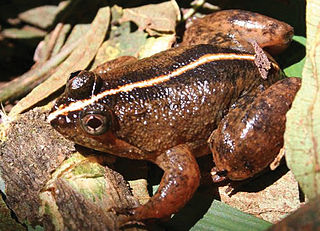The Seychelles palm frog is a species of frog that is endemic to Silhouette Island in the Seychelles. It is closely related to Gardiner's frog, Sechellophryne gardineri.

The palm forest tree frog is a species of frog in the family Arthroleptidae which is endemic to Príncipe island in São Tomé and Príncipe. Red tree frog Leptopelis rufus from the African mainland was for a long time included in this species, but is now considered a distinct species.
Limnonectes fragilis is a species of frog in the family Dicroglossidae. It is endemic to the Hainan Island, China. It is a medium-sized frog, males being 49 mm (1.9 in) and females 52 mm (2.0 in) snout-vent length. Its natural habitats are subtropical or tropical moist lowland forest and rivers. It is threatened by habitat loss.

The common puddle frog, puddle frog, or yellow bellied puddle frog is a species of frog in the family Dicroglossidae. It has often been confused with Occidozyga sumatrana and records of this species outside the Philippines likely represent that species.

Platymantis corrugatus is a species of frog in the family Ceratobatrachidae. It is endemic to the Philippines, where it is found throughout the archipelago except Palawan. Its natural habitats are tropical moist lowland forest and subtropical or tropical moist montane forest. It is threatened by habitat loss. Platymantis corrugatus is one of the most common Platymantis species in the Philippines.

Nidirana adenopleura is a species of frog in the family Ranidae. It is found in Taiwan, south-eastern China, and in the Yaeyama Islands. Populations from Yaeyama Islands might represent a distinct, as yet undescribed species. The records from Vietnam and Thailand are uncertain.
The Emei music frog is a species of frog in the family Ranidae. It is endemic to China, and is found in central China, in southeastern Sichuan, northeastern Yunnan and western Guizhou provinces. The species name refers to the type locality, Mount Emei in Sichuan, and its vocalizing abilities. The original name Rana musica was replaced with Rana daunchina as the former name was already taken.
Nidirana lini is a species of frog in the family Ranidae. It is known with some certainty from southern Yunnan (China), Laos, Thailand, and north-western Vietnam. It has been mixed with Nidirana adenopleura and Nidirana chapaensis; its exact distribution is unclear, in particular whether populations referred to as N. adenopleura in southern China to Zhejiang in the east belong to this species.
The island leopard frog or Little Corn Island frog is a species of frogs in the family Ranidae, endemic to Little Corn Island off the Caribbean coast of Nicaragua. It is locally known as rana leopardo isleña.

The Ryukyu tip-nosed frog, Ryukyu Island frog, or Okinawa tip-nosed frog is a species of frog in the family Ranidae. It is endemic to Okinawa Island, in the Ryukyu Islands of Japan.

The Perez's frog, also known as Iberian waterfrog, Iberian green frog or Coruna frog, is a species of frog in the family Ranidae. It is native to southern France, Portugal, Spain, and has been introduced to the Canary and Balearic Islands, Madeira, the United Kingdom, and the Azores. In the Iberian Peninsula it is widespread and common.

The Kampira Falls frog, also known as the Yaeyama harpist frog or harpist brown frog, is a species in the true frog family (Ranidae). Until recently known as Rana psaltes, it is found on Ishigaki and Iriomote in the Yaeyama Islands of Japan, as well as on Taiwan.
The Otton frog, is a species of frog in the family Ranidae. It is endemic to the islands of Amami Ōshima and Kakeromajima in the Ryukyu Islands, Japan. Its natural habitats are subtropical or tropical moist lowland forests, freshwater marshes, and intermittent freshwater marshes. Once considered a delicacy as a source of food, it is now threatened by habitat loss through deforestation, and predation by introduced mongooses. Otton Frogs have a lifespan of approximately 7 years which is significantly different to common frog species’ life span of 10 -12 years. Due to the isolated island ecosystem, many factors play into the endangerment and the shorter lifespan of the species.

The Tago's brown frog or simply Tago frog is a species of frog in the family Ranidae endemic to Japan. It is widely distributed within Japan and found on Honshu, Shikoku, and Kyushu, as well as on some outlying islands. There are two subspecies:
The Faro Island tree frog, also known as Solomon Islands treefrog, is a species of frog in the subfamily Pelodryadinae. It is found in Papua New Guinea and Solomon Islands. Its natural habitat is subtropical or tropical moist lowland forests. It is threatened by habitat loss.

Pulchrana baramica, the Baram River frog, brown marsh frog, or masked rough-sided frog, is a species of "true frog", family Ranidae. It is found in the Malay Peninsula, including the extreme south Thailand, Peninsular Malaysia, and Singapore, and in the Malay Archipelago, including Borneo, and the Indonesian islands Java, Sumatra, and Bangka Island. Its type locality is the Baram River in Sarawak, Malaysia, giving it one of its common names. Its natural habitats are tropical moist lowland forests and swamps. It is not considered threatened by the IUCN.

Babina is a genus of frogs in the family Ranidae from south-eastern and eastern Asia. Formerly, Babina was considered as a subgenus of Rana.
Nidirana chapaensis, commonly known as the Chapa frog or glandular-sided frog, is a species of frog in the family Ranidae. It is found in Laos, Vietnam, and Thailand, although records from Thailand may refer to Nidirana lini.











